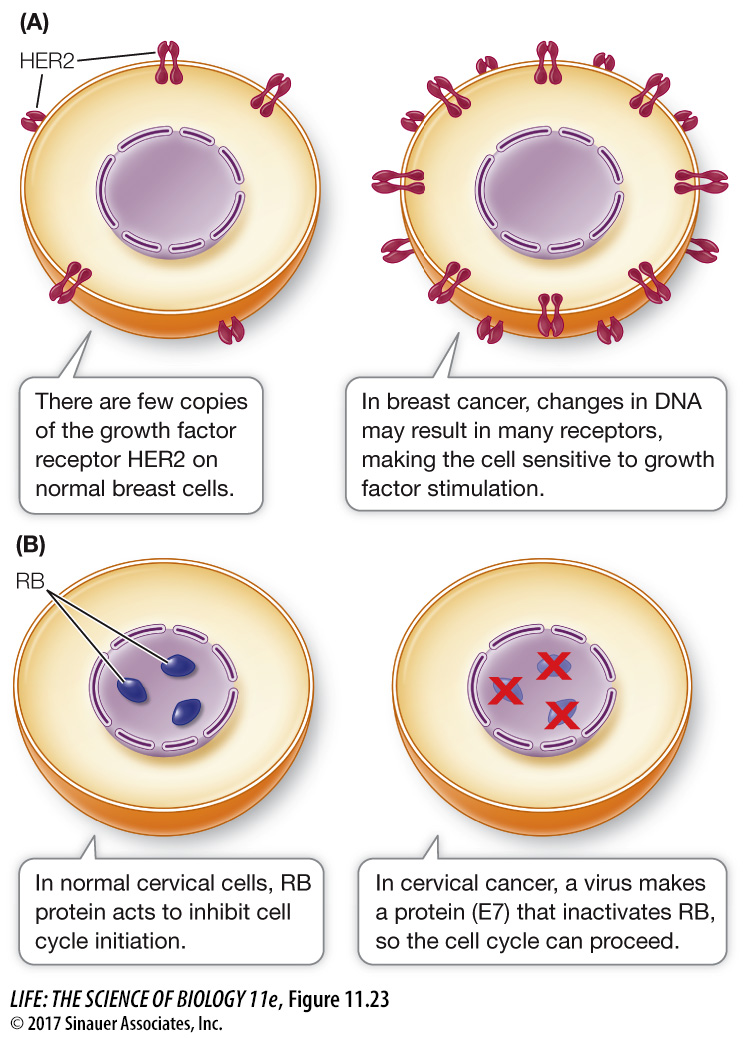Cancer cells lose control over the cell cycle and apoptosis
Earlier in this chapter you learned about proteins that regulate the progress of a eukaryotic cell through the cell cycle:
Positive regulators such as growth factors stimulate the cell cycle: they are like “gas pedals.”
Negative regulators such as retinoblastoma protein (RB) inhibit the cell cycle: they are like “brakes.”
Just as driving a car requires stepping on the gas pedal and releasing the brakes, a cell will go through a division cycle only if the positive regulators are active and the negative regulators are inactive.
In most cells, the two regulatory systems ensure that the cells divide only when needed. In cancer cells, these two processes are abnormal.
Oncogene proteins are positive regulators in cancer cells. They are derived from normal positive regulators that have become mutated to be overly active or that are present in excess, and they stimulate the cancer cells to divide more often. Oncogene products could be growth factors, their receptors, or other components in the signal transduction pathways (see Chapter 7) that stimulate cell division. An example of an oncogene protein is a growth factor receptor in a breast cancer cell (Figure 11.23A). Normal breast cells have relatively low numbers of the human epidermal growth factor receptor HER2. So breast cells are not usually stimulated to multiply in the presence of this growth factor. In about 25 percent of breast cancers, a DNA change results in the increased production of the HER2 receptor. This results in positive stimulation of the cell cycle, and a rapid proliferation of cells with the altered DNA.
 Figure 11.23 Molecular Changes in Cancer Cells In cancer, oncogene proteins become active (A) and tumor suppressor proteins become inactive (B).
Figure 11.23 Molecular Changes in Cancer Cells In cancer, oncogene proteins become active (A) and tumor suppressor proteins become inactive (B).Tumor suppressors are negative regulators in both cancer and normal cells, but in cancer cells they are inactive. An example is the RB protein, which when active acts at R (the restriction point) in G1 to block the cell cycle (see Figure 11.5). In some cancer cells RB is inactive, allowing the cell cycle to proceed. Some viral proteins can inactivate tumor suppressors. For example, the human papillomavirus infects cells of the cervix and produces a protein called E7. E7 binds to the RB protein and prevents it from inhibiting the cell cycle (Figure 11.23B). Another important tumor suppressor is p53, a transcription factor that is involved in cell cycle checkpoint pathways and apoptosis. The importance of p53 as a tumor suppressor is illustrated by the fact that more than 50 percent of human tumors have mutations in the gene that encodes p53.
With oncogenes (the gas pedal) and tumor suppressor genes (the brakes), it takes more than one protein to allow the cancer cell cycle to proceed. There may be several oncogenes and tumor supressor genes involved in a single tumor. For example, two important oncogenes in mouse cells are Myc, whose expression stimulates the cell cycle and prevents apoptosis, and Ras, a signaling molecule you saw in Figure 7.10). Experiments show that it takes the expression of both of these oncogenes to set the cell cycle in motion in mouse cells and convert them into tumor cells (Figure 11.24).
experiment

Figure 11.24 Does It Take Multiple Events to Trigger the Cancer Cell Cycle?
Original Papers: Land, H., L. Parada and R. A. Weinberg. 1983. Tumorigenic conversion of primary embryo fibroblasts required at least two cooperating oncogenes. Nature 304: 596–
Sinn, E., W. Muller, P. Pattengale, I. Tepler, R. Wallace and P. Leder. 1987. Coexpression of MMTV/v-
Experiments using mouse cells in the laboratory showed that the expression of more than one oncogene is required to transform a normal cell into a cancer cell.
A work with the data exercise that accompanies this figure may be assigned in LaunchPad.
236
The discovery of apoptosis (see Key Concept 11.6) changed the way biologists think about cancer. In a population of cells, the net increase in cell numbers over time (the growth rate) is a function of cells added (the rate of cell division) and cells lost (the rate of apoptosis):
Growth rate of cell population = rate of cell division – rate of apoptosis
In normal nongrowing tissues, the rate of cell division equals the rate of apoptosis, so the cell population as a whole does not grow. Cancer cells are defective in their regulation of the cell cycle, resulting in increased rates of cell division. In addition, cancer cells can lose the ability to respond to positive regulators of apoptosis (see Figure 11.22), and this results in lowered rates of cell death. Both of these defects favor an increased growth rate of the cancer cell population.